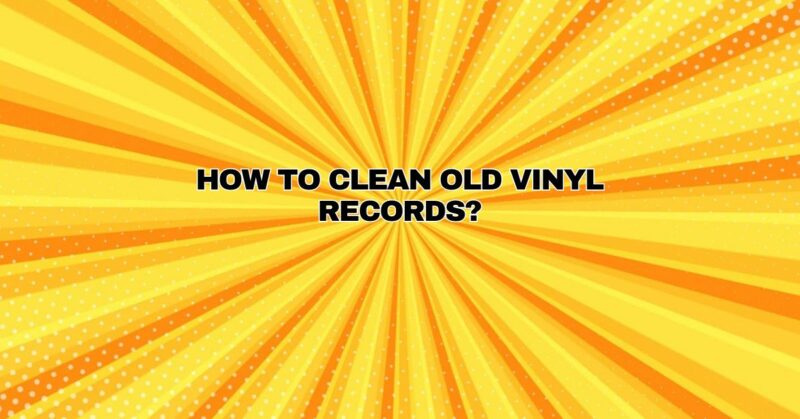Vinyl records hold a special place in the hearts of music enthusiasts for their warm and authentic sound. Many collectors treasure vintage vinyl records, which may have been stored away for years, passed down through generations, or discovered in thrift stores and flea markets. However, old records often require special care and cleaning to restore their sound quality and ensure a pleasurable listening experience. In this comprehensive guide, we’ll walk you through the steps to clean old vinyl records safely and effectively.
Materials You’ll Need:
- Anti-Static Brush: For removing loose dust and debris from the record surface.
- Record Cleaning Solution: A dedicated record cleaning fluid for deep cleaning.
- Distilled Water: For diluting cleaning solutions and rinsing.
- Microfiber Cloth or Towel: For drying and handling records.
- Soft Bristle Brush: A dedicated record cleaning brush with fine bristles.
- Record Cleaning Mat or Pad (Optional): To create a clean and stable surface for cleaning.
- Record Cleaning Machine (Optional): While not necessary, a record cleaning machine can simplify the process and provide consistent results.
- Vinyl Outer Sleeves: To protect cleaned records.
Step-by-Step Guide to Cleaning Old Vinyl Records:
1. Set Up Your Workspace:
Choose a clean, well-lit, and clutter-free area to work in. Ensure that your hands are clean and dry before handling records to prevent transferring oils and contaminants.
2. Examine the Record:
Before you start cleaning, visually inspect the old record for visible dust, dirt, or debris. Note any visible damage or wear, such as scratches or scuffs, as these may affect the record’s sound quality.
3. Dry Cleaning (Optional):
Begin by using an anti-static brush specifically designed for vinyl records. Gently brush the record from the back to the front (never side to side) to remove any loose dust and debris. This step helps prevent scratching during the wet cleaning process.
4. Prepare the Cleaning Solution:
If you’re using a record cleaning machine, follow the manufacturer’s instructions for the recommended cleaning solution. For manual cleaning, create a cleaning solution by mixing distilled water with a dedicated record cleaning fluid. The mixing ratio typically ranges from 1:5 to 1:10 (cleaning solution to distilled water). Avoid using tap water, as it may contain minerals that can leave residue on the records.
5. Place the Record on a Stable Surface:
Set the old record on a clean, stable surface, such as a felt mat or record cleaning pad. Ensure that the record is secure and won’t slip during cleaning.
6. Apply the Cleaning Solution:
With the record spinning (either manually or on a turntable), apply the cleaning solution evenly across the entire record’s surface. You can use a dedicated record cleaning brush or a soft bristle brush designed for use with cleaning fluid. Ensure that the solution covers the entire record, including the grooves.
7. Brush and Vacuum (Record Cleaning Machine):
If you’re using a record cleaning machine, engage the cleaning and vacuuming functions as per the manufacturer’s instructions. The machine will typically brush the record to agitate the cleaning solution and then vacuum it away, along with dirt and contaminants.
8. Manual Cleaning (Optional):
For manual cleaning, use a soft bristle brush or dedicated record cleaning brush to gently scrub the old record’s surface. Brush in the direction of the grooves, ensuring you cover the entire surface. Be careful not to apply excessive pressure, as it can potentially damage the grooves.
9. Rinse the Record:
After cleaning, rinse the old record thoroughly with distilled water to remove any remaining cleaning solution and contaminants. Gently dampen a clean, lint-free cloth or microfiber towel with distilled water and wipe the record’s surface. Alternatively, use a separate brush for this purpose.
10. Dry the Record:
Use a clean, dry microfiber cloth or towel to pat the record dry. Gently blot the surface to remove excess moisture. Ensure the record is completely dry before storing it or playing it again.
11. Store Cleaned Records:
Place the cleaned old record in a protective inner sleeve to prevent dust and contaminants from settling on its surface. Store it vertically to prevent warping.
12. Repeat as Needed:
Depending on the level of dirt, dust, or contaminants on the old record, you may need to repeat the cleaning process multiple times for optimal results.
13. Handle with Care:
Always handle old records with care to avoid unnecessary wear and damage. Hold them by their edges and labels to prevent touching the grooves with your fingers.
Cleaning old vinyl records is a meticulous but rewarding process that can breathe new life into vintage gems. By following these steps and taking your time, you can effectively remove embedded dirt, grime, and contaminants and restore the sound quality of your cherished collection. Proper care and attention to detail ensure that you continue to enjoy the unique and nostalgic sound of vinyl records, even those that have been treasured for generations.


